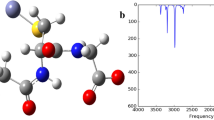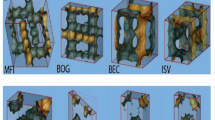Abstract
In this paper, an adsorption removal mechanism of heavy metal ions (Pb, Cu, Cd, Zn, and Ni) by lignin is investigated by molecular and quantum chemical modeling. First, the lowest energy sites of lignin for heavy metal ions were investigated using a Metropolis Monte Carlo search and simulated annealing. Then, equilibrium adsorption capacities of lignin for heavy metal ions were calculated with conductor-like screening models with a segmented activity coefficients, together with generalized gradient approximation and Volsko–Wilk–Nusair density functional functional theory. These calculations followed the local pseudo-thermodynamic equilibrium at the interface of lignin and ion-containing effluent. Several kinetic Monte Carlo simulations were performed to analyze the surface kinetics of ion adsorption. The affinity of lignin for metal ions follows the order: Pb > Cu > Cd > Zn > Ni which is in agreement with experimental observations. The stability of ions follows the order: Pb > Cd > Zn > Ni > Cu, indicating that the adsorption affinity does not demand the same order of stability on ions. In addition, it was found that while the adsorption of heavy metal ions on the lignin is accessible, the adsorbed heavy metal ions, however, are less stable than the adsorbed water molecules. As such, the used lignin must be replaced by fresh lignin in a cyclic manner. While lignin provides desirable adsorption performance for single ion removal, it failed in processing of practical heavy metal ion solutions expected in environmental issues.









Similar content being viewed by others
References
Aksu Z, Kabasakal E (2004) Batch adsorption of 2,4-dichlorophenoxy-acetic acid (2,4-D) from aqueous solution by granular activated carbon. Sep Purif Technol 35(3):223–240. doi:10.1016/s1383-5866(03)00144-8
Ali Aroon M, Khansary MA (2017) Generalized similarity transformation method applied to partial differential equations (PDEs) in falling film mass transfer. Comput Chem Eng 101:73–80. doi:10.1016/j.compchemeng.2017.02.047
Asgarpour Khansary M, Shirazian S, Asadollahzadeh M (2017) Polymer-water partition coefficients in polymeric passive samplers. Environ Sci Pollut Res Int 24(3):2627–2631. doi:10.1007/s11356-016-8029-7
Babu BV, Gupta S (2007) Adsorption of Cr(VI) using activated neem leaves: kinetic studies. Adsorption 14(1):85–92. doi:10.1007/s10450-007-9057-x
Bergmair D, Metz SJ, de Lange HC, van Steenhoven AA (2015) A low pressure recirculated sweep stream for energy efficient membrane facilitated humidity harvesting. Sep Purif Technol 150:112–118. doi:10.1016/j.seppur.2015.06.042
Berninger JA, Whitley RD, Zhang X, Wang NHL (1991) A versatile model for simulation of reaction and nonequilibrium dynamics in multicomponent fixed-bed adsorption processes. Comput Chem Eng 15(11):749–768. doi:10.1016/0098-1354(91)85020-U
Borba CE, Guirardello R, Silva EA, Veit MT, Tavares CRG (2006) Removal of nickel(II) ions from aqueous solution by biosorption in a fixed bed column: experimental and theoretical breakthrough curves. Biochem Eng J 30(2):184–191. doi:10.1016/j.bej.2006.04.001
Brauch V, Schlünder EU (1975) The scale-up of activated carbon columns for water purification, based on results from batch tests—II. Chem Eng Sci 30(5–6):539–548. doi:10.1016/0009-2509(75)80024-8
Černý V (1985) Thermodynamical approach to the traveling salesman problem: an efficient simulation algorithm. J Optim Theory Appl 45(1):41–51. doi:10.1007/bf00940812
Costa C, Rodrigues A (1985) Design of cyclic fixed-bed adsorption processes. Part I: phenol adsorption on polymeric adsorbents. AIChE J 31(10):1645–1654. doi:10.1002/aic.690311008
Dassault Systemes Materials Studio Tutorials (2017). BIOVIA Support, 5005 Wateridge Vista Drive, San Diego, CA 92121 USA
Do DD, Mayfield PLJ (1987) A new simplified model for adsorption in a single particle. AIChE J 33(8):1397–1400. doi:10.1002/aic.690330819
Foo KY, Hameed BH (2010) Insights into the modeling of adsorption isotherm systems. Chem Eng J 156(1):2–10. doi:10.1016/j.cej.2009.09.013
Ghasemi A, Asgarpour Khansary M, Marjani A, Shirazian S (2017) Using quantum chemical modeling and calculations for evaluation of cellulose potential for estrogen micropollutants removal from water effluents. Chemosphere 178:411–423. doi:10.1016/j.chemosphere.2017.02.152
Gholami M, Talaie MR (2010) Investigation of simplifying assumptions in mathematical modeling of natural gas dehydration using adsorption process and introduction of a new accurate LDF model. Ind Eng Chem Res 49(2):838–846. doi:10.1021/ie901183q
Gido B, Friedler E, Broday DM (2016) Assessment of atmospheric moisture harvesting by direct cooling. Atmos Res 182:156–162. doi:10.1016/j.atmosres.2016.07.029
Guo X, Zhang S, Shan XQ (2008) Adsorption of metal ions on lignin. J Hazard Mater 151(1):134–142. doi:10.1016/j.jhazmat.2007.05.065
Hashemi F, Parham H (2006) Heavy Metal Removal from Effluents using Adsorption. Iran Chem Eng J (Persian) 5(23):45–52
Ho Y (2006) Review of second-order models for adsorption systems. J Hazard Mater 136(3):681–689. doi:10.1016/j.jhazmat.2005.12.043
Ho YS, McKay G (1999) Pseudo-second order model for sorption processes. Process Biochem 34(5):451–465. doi:10.1016/s0032-9592(98)00112-5
Islam MR, Chen C-C (2014) COSMO-SAC Sigma Profile Generation with Conceptual Segment Concept. Ind Eng Chem Res. doi:10.1021/ie503829b
Islam MR, Chen C-C (2015) COSMO-SAC sigma profile generation with conceptual segment concept. Ind Eng Chem Res 54(16):4441–4454. doi:10.1021/ie503829b
Kaczmarski K, Mazzotti M, Storti G, Morbidelli M (1997) Modeling fixed-bed adsorption columns through orthogonal collocations on moving finite elements. Comput Chem Eng 21(6):641–660. doi:10.1016/S0098-1354(96)00300-6
Khansary MA, Joogh FKQ, Hosseini A, Safari J, Allahyari E, Zadeh NS, Sani AH (2014) Modeling Drying of a Coated Paper. Int J Model Simul Sci Comput 05(01):1350019. doi:10.1142/s1793962313500190
Khansary MA, Mellat M, Saadat SH, Fasihi-Ramandi M, Kamali M, Taheri RA (2017) An enquiry on appropriate selection of polymers for preparation of polymeric nanosorbents and nanofiltration/ultrafiltration membranes for hormone micropollutants removal from water effluents. Chemosphere 168:91–99. doi:10.1016/j.chemosphere.2016.10.049
Kirkpatrick S, Gelatt CD, Vecchi MP (1983) Optimization by simulated annealing. Science 220(4598):671–680. doi:10.1126/science.220.4598.671
Klamt A (2005a) COSMO-RS: from quantum chemistry to fluid phase thermodynamics and drug design. Elsevier, Amsterdam
Klamt A (2005b) COSMO-RS from quantum chemistry to fluid phase thermodynamics and drug design. Elsevier, Amsterdam
Klamt A, Krooshof GJP, Taylor R (2002) COSMOSPACE: alternative to conventional activity-coefficient models. AIChE J 48(10):2332–2349. doi:10.1002/aic.690481023
Ko DCK, Porter JF, McKay G (2003) Mass transport model for the fixed bed sorption of metal ions on bone char. Ind Eng Chem Res 42(14):3458–3469. doi:10.1021/ie020505t
Limousin G, Gaudet JP, Charlet L, Szenknect S, Barthès V, Krimissa M (2007) Sorption isotherms: a review on physical bases, modeling and measurement. Appl Geochem 22(2):249–275. doi:10.1016/j.apgeochem.2006.09.010
Liu Y (2008) New insights into pseudo-second-order kinetic equation for adsorption. Coll Surf A 320(1–3):275–278. doi:10.1016/j.colsurfa.2008.01.032
Mahmoud B, Yosra M, Nadia A (2016) Effects of magnetic treatment on scaling power of hard waters. Sep Purif Technol 171:88–92. doi:10.1016/j.seppur.2016.07.027
Metropolis N, Rosenbluth AW, Rosenbluth MN, Teller AH, Teller E (1953) Equation of state calculations by fast computing machines. J Chem Phys 21(6):1087–1092. doi:10.1063/1.1699114
Shafeeyan MS, Wan Daud WMA, Shamiri A (2014) A review of mathematical modeling of fixed-bed columns for carbon dioxide adsorption. Chem Eng Res Des 92(5):961–988. doi:10.1016/j.cherd.2013.08.018
Shah MR, Yadav GD (2013) Prediction of sorption in polymers using quantum chemical calculations: application to polymer membranes. J Membr Sci 427:108–117. doi:10.1016/j.memsci.2012.09.037
Tosun I (2007) Modeling in transport phenomena: a conceptual approach, 2nd edn. Elsevier, Amsterdam
Toure O, Audonnet F, Lebert A, Dussap C-G (2014) COSMO-RS-PDHS: a new predictive model for aqueous electrolytes solutions. Chem Eng Res Des 92(12):2873–2883. doi:10.1016/j.cherd.2014.06.020
Trapani F, Polyzoidis A, Loebbecke S, Piscopo CG (2016) On the general water harvesting capability of metal-organic frameworks under well-defined climatic conditions. Microporous Mesoporous Mater 230:20–24. doi:10.1016/j.micromeso.2016.04.040
Weber WJ, Smith EH (1987) Simulation and design models for adsorption processes. Environ Sci Technol 21(11):1040–1050. doi:10.1021/es00164a002
Worch E (2008) Fixed-bed adsorption in drinking water treatment: a critical review on models and parameter estimation. J Water Supply: Res Technol—AQUA 57(3):171. doi:10.2166/aqua.2008.100
Wu F-C, Tseng R-L, Huang S-C, Juang R-S (2009) Characteristics of pseudo-second-order kinetic model for liquid-phase adsorption: a mini-review. Chem Eng J 151(1–3):1–9. doi:10.1016/j.cej.2009.02.024
Xu Z, J-g Cai, B-c Pan (2013) Mathematically modeling fixed-bed adsorption in aqueous systems. J Zhejiang Univ Sci A 14(3):155–176. doi:10.1631/jzus.A1300029
Xu M, Bai X, Pei L, Pan H (2016) A research on application of water treatment technology for reclaimed water irrigation. Int J Hydrogen Energy 41(35):15930–15937. doi:10.1016/j.ijhydene.2016.05.020
Zanacic E, Stavrinides J, McMartin DW (2016) Field-analysis of potable water quality and ozone efficiency in ozone-assisted biological filtration systems for surface water treatment. Water Res 104:397–407. doi:10.1016/j.watres.2016.08.043
Author information
Authors and Affiliations
Corresponding author
Electronic supplementary material
Below is the link to the electronic supplementary material.
Appendix
Appendix
The mole fractions (z) can be converted to concentrations (c) using the following expression:
where M denotes molecular weight (\(M = \sum {z_{i} M_{i} }\)) and ρ is density (\(\rho = \sum {\rho_{i} }\)).
The mole fractions (z) can be related to the amount of adsorbed adsorbate (q A ) as z = ε \(q_{A}\) using the following expression:
The unit of \(\frac{{n_{1} }}{{m_{2} }}\) is mol/gr; thus, to give mmol/gr, both sides of Eq. 6 are multiplied by 10−3.
Rights and permissions
About this article
Cite this article
Karezani, E., Hallajisani, A. & Asgarpour Khansary, M. A quantum mechanics/molecular mechanics (QM/MM) investigation on the mechanism of adsorptive removal of heavy metal ions by lignin: single and competitive ion adsorption. Cellulose 24, 3131–3143 (2017). https://doi.org/10.1007/s10570-017-1329-3
Received:
Accepted:
Published:
Issue Date:
DOI: https://doi.org/10.1007/s10570-017-1329-3




